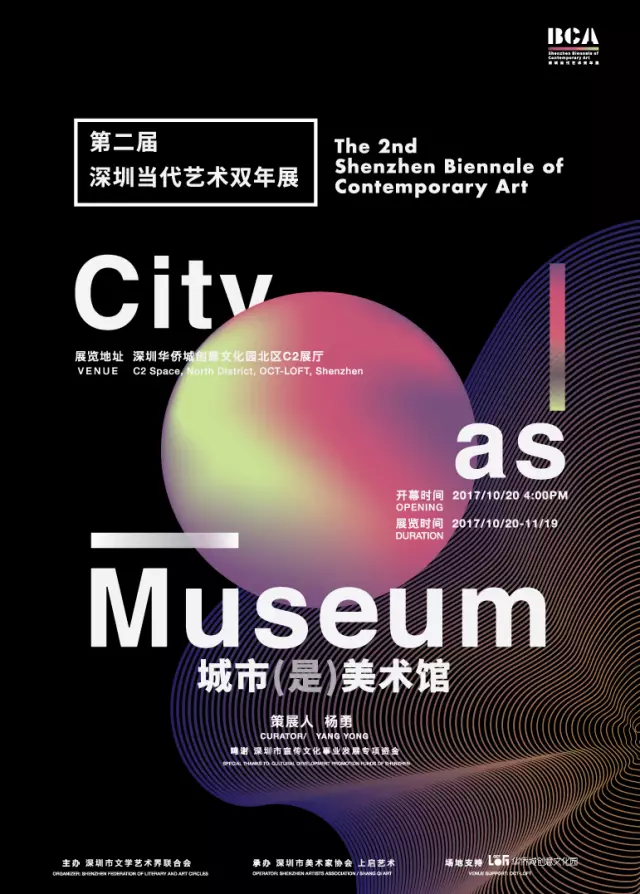Time
Oct. 20-Nov. 19
Tickets
SZ contemporary art biennale| Oct. 20-Nov. 19
Venue
Metro
Line 2, Qiaocheng North Station (侨城北站), Exit B
Oct. 20-Nov. 19
SZ contemporary art biennale| Oct. 20-Nov. 19
Line 2, Qiaocheng North Station (侨城北站), Exit B

Artists from Shenzhen and partner cities will showcase their latest work at “City As Museum: The Second Shenzhen Biennale of Contemporary Art” on Oct. 20-Nov. 19 at the spacious C2 Hall in OCT-LOFT in Nanshan District.
第二届深圳当代艺术双年展以“城市(是)美术馆”为主题。面对深圳乃至全国进入“美术馆时代”的发展现象,对城市化推动下的美术馆及各类文化设施的建设风潮进行探讨。
本次展览中艺术家对这一主题的回应和学者的研究,将为公众展现城市文化与当代艺术的现状,引发专业人士和公众对公共领域文化机构、美术馆、艺术展览的定位与运营的反思与关注。
Organized by the Shenzhen Literature and Art Federation, Shenzhen Fine Artists Association and Shangqi Art, the exhibition will feature both emerging artists and established names. Two-thirds of the exhibitors will be Shenzhen-based artists, according to the biennale curator Yang Yong.
This year, the biennale will focus on “city” and fine-tune the art museums’ positioning.
“In the process of China’s urbanization, many cities have built more and more galleries, art museums or art spaces, and Shenzhen is no exception. Having more galleries in a city seems like a trendy act but the positioning of the galleries or how to operate art museums is seldom discussed. Artists should think about these questions,” said Yang Xiaoyang, vice director of Shenzhen Fine Artists Association and vice curator of Shenzhen Fine Art Institute.
策展人杨勇对主题进行了阐释:今天的美术馆已经成为一种城市文化的象征,成为一种城市、社区文化交流的可能介质,成为一种开放、包容与多元文化意识的代表,更成为一种了解区域、洞察世界的思维方式。多维度探讨美术馆本身——从具象的机构到抽象的概念——与当下城市及文化发展之间的密切关系,是今天我们选择美术馆作为梳理城市文化架构切入点的初衷。
“We will also examine the condition of Shenzhen contemporary art through the biennale,” said Shenzhen artist Xu Tan.
“In the 1990s, the Pearl River Delta area was regarded as a ‘cultural desert’ by artists in northern China. In 1997, Huang Zhuan (then-curator of He Xiangning Art Museum) began to push Shenzhen art organizations to engage in contemporary art. At that time, there were only two to three contemporary artists in Shenzhen. After 2000, artists Jiang Zhi and Li Jinhu came to Shenzhen but finally moved to Beijing. So we hope to improve Shenzhen’s contemporary art culture through this biennale,” said Xu.
Shenzhen artist and poet Zhang Yuxing believes that to build a healthy art scene in the city, support from local governments, financial institutions and local artists are necessary.
“An art museum is not only a building, but also a cultural organization which collects and displays artworks, carries out research and spreads knowledge to the public. Developing art museums needs local government’s open-minded policies, enterprises’ capital support and efforts from artists and art communities,” said Zhang.
Among this year’s biennale artists, some are from local art museums, such as Guan Shanyue Art Museum curator Chen Xiangbo; some are independent artists like Xu Tan and Zhang Yuxing; and some are from Beijing, Shanghai and Rome, such as Fang Lijun and Wang Luyan.
The biennale will invite international art curator and critic Hou Hanru, OCAT Shenzhen curator Luan Qian, Artron Art Group chairman Wan Jie, Asia Art Archive co-founder and director Claire Hsu, artist and Shangqi Art founder Yang Yong, Beijing Yang Gallery founder and artistic director Yang Yang and Guangdong Times Museum curator Zhao Qie as the developmental committee members.
The first contemporary art biennale was held in 2015 at Shenzhen University’s art museum, with subvenues in Shekou and Guangming New Area.